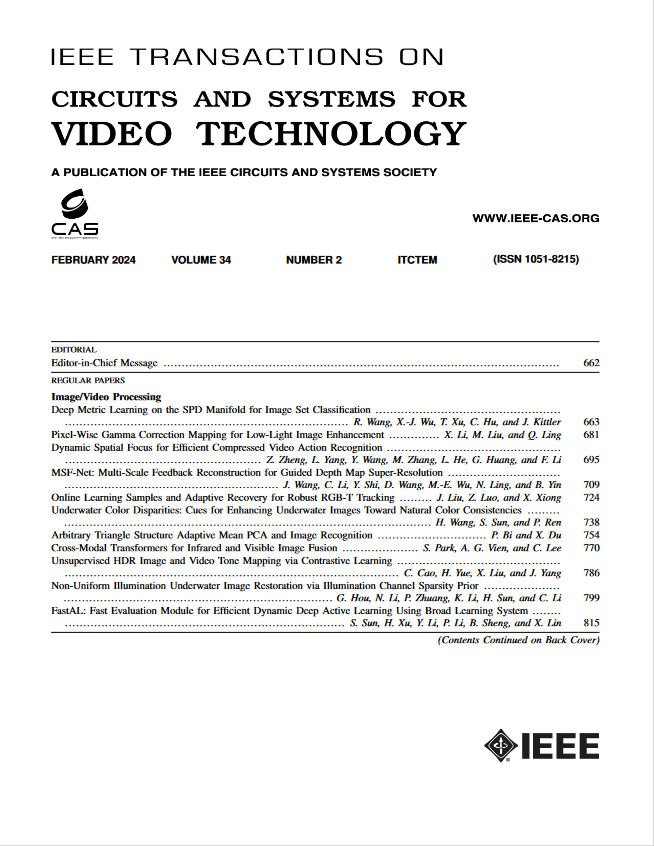VFM-Depth: Leveraging Vision Foundation Model for Self-Supervised Monocular Depth Estimation
IF 8.3
1区 工程技术
Q1 ENGINEERING, ELECTRICAL & ELECTRONIC
IEEE Transactions on Circuits and Systems for Video Technology
Pub Date : 2024-12-27
DOI:10.1109/TCSVT.2024.3523702
引用次数: 0
Abstract
Self-supervised monocular depth estimation has exploited semantics to reduce depth ambiguities in texture-less regions and object boundaries. However, existing methods struggle to obtain universal semantics across scenes for effective depth estimation. This paper proposes VFM-Depth, a novel self-supervised teacher-student framework, that effectively leverages the vision foundation model as semantic regularization to significantly improve the accuracy of monocular depth estimation. Firstly, we propose a novel Geometric-Semantic Aggregation Encoding, integrating universal semantic constraints from the foundation model to reduce ambiguities in the teacher model. Specifically, semantic features from the foundation model and geometric features from the depth model are first encoded and then fused through cross-modal aggregation. Secondly, we introduce a novel Multi-Alignment for Depth Distillation to distill semantic constraints from the teacher, further leveraging knowledge from the foundation model. We obtain a lightweight yet effective student model through an innovative approach that combines distance category alignment with complementary feature and depth imitation. Extensive experiments on KITTI, Cityscapes, and Make3D datasets demonstrate that VFM-Depth (both teacher and student) outperforms state-of-the-art self-supervised methods by a large margin.VFM-Depth:利用视觉基础模型进行自监督单目深度估计
自监督单目深度估计利用语义来减少无纹理区域和目标边界的深度模糊。然而,现有的方法难以获得跨场景的通用语义来进行有效的深度估计。本文提出了一种新的自监督师生框架VFM-Depth,该框架有效地利用视觉基础模型作为语义正则化,显著提高了单目深度估计的精度。首先,我们提出了一种新的几何语义聚合编码,整合了基础模型中的通用语义约束,以减少教师模型中的歧义。首先对基础模型的语义特征和深度模型的几何特征进行编码,然后通过跨模态聚合进行融合。其次,我们引入了一种新的深度蒸馏的多对齐方法来提取教师的语义约束,进一步利用基础模型中的知识。我们通过一种创新的方法,将距离类别对齐与互补特征和深度模仿相结合,获得了一个轻量级但有效的学生模型。在KITTI、cityscape和Make3D数据集上进行的大量实验表明,VFM-Depth(包括教师和学生)在很大程度上优于最先进的自我监督方法。
本文章由计算机程序翻译,如有差异,请以英文原文为准。
求助全文
约1分钟内获得全文
求助全文
来源期刊
CiteScore
13.80
自引率
27.40%
发文量
660
审稿时长
5 months
期刊介绍:
The IEEE Transactions on Circuits and Systems for Video Technology (TCSVT) is dedicated to covering all aspects of video technologies from a circuits and systems perspective. We encourage submissions of general, theoretical, and application-oriented papers related to image and video acquisition, representation, presentation, and display. Additionally, we welcome contributions in areas such as processing, filtering, and transforms; analysis and synthesis; learning and understanding; compression, transmission, communication, and networking; as well as storage, retrieval, indexing, and search. Furthermore, papers focusing on hardware and software design and implementation are highly valued. Join us in advancing the field of video technology through innovative research and insights.

 求助内容:
求助内容: 应助结果提醒方式:
应助结果提醒方式:


